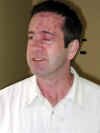Non Hodgkin's Lymphoma
Cyberfamily
Shingles
Shingles are the most unwanted aspect of any immuno-compromised patient. They can be a nightmare. Not convinced? Just look at your webmasters picture on the left. Click on it for a bigger view if you wish. Not a pretty sight is it?
This page is here because anyone who has a compromised immune system is at higher risk to get shingles. That means patients who have had an SCT have a very high risk of getting them, and even chemotherapy patients are at increased risk.
What is shingles?
Shingles is caused by the herpes zoster virus. This is the same virus that causes Chicken Pox. The only people who can have shingles are people who have already had chicken pox.
After your chicken pox heals, some of the virus travels down a nerve until it reaches the base of the nerve near your spine. It will lay there dormant, just waiting for a chance to re-awaken. For many people that will never happen but for anyone who has a compromised immune system it can easily happen. When it does the virus travels back up that same nerve until it comes to the surface. Since all your nerves only go to one side of your body, shingles will break out only on one side or the other. It is easily identified because the blisters appear only on one side of the body. Just look at my picture above to see how obvious it is.
Shingle are NOT contagious. You cannot catch shingles from another person. Shingles is ONLY a reoccurrence of your own herpes zoster virus which was laying dormant in your own nerve roots.
People who have never had chicken pox can catch chicken pox if they come into contact with a person who has active shingles. If you have already had chicken pox then you cannot catch anything from a person with shingles.
Shingles are usually extremely painful and can leave permanent damage in the form of Postherpatic Neuralgia. This PHN as it is called, and last for a few weeks or months, and in some cases years.
What does this have to do with SCT?
Patients who have had an SCT are at very high risk of getting shingles at some point. It could be months, or years after their SCT. Their compromised immune system means that the herpes zoster virus is just looking for an opportunity to awaken once again.
There is nothing you can do to stop a reoccurrence or cure shingles. But there is something you can to that may lessen the severity of the outbreak and reduce the chance of PHN. Antiviral medications, if taken within 48 hours of the first sign of shingles rash/blisters can reduce the severity, duration, and risk of later complications. Three of the most commonly prescribed antiviral medications are Acyclovir, Famciclovir, Valacyclovir. These medications need to be taken within 48 hours of the first outbreak in order to be effective and reduce the chance of PHN.
You would do well to carry a prescription for any one of those in your wallet/purse all the time. If you happen to be somewhere where you do not have access to a doctor in less than 48 hours then this prescription means you can start therapy quicker, which may make a big difference.
READ HERE FOR MORE INFORMATION ABOUT SHINGLES
Shingles, an unwanted encore from the United States FDA
Shingles, Hope through research
© 2006 NHL Cyberfamily All Rights Reserved.
Web design by Long2 Consulting
